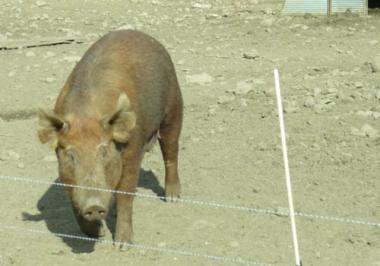A couple of weeks ago, while Mexico suffered multiple fatalities due to what was being referred to as "swine flu" (also known as "H1N1"), I visited a pig farm in the Berkshires to do a story and got chased off the place. The 36-year-old farmer, Sean Stanton, works closely with high-profile chef Dan Barber, a guy who touts his collaboration with growers. Stanton's hogs are headliners on menus in New York as well as the Berkshires, so I went to interview him.
Milking time was the only opportunity Stanton had to talk, so I showed up at 8 a.m. Typically, farms are a picture of carefully tended beds of greens, hen houses dotting the landscape and horse barns off in the distance. This place was more of a free-range enterprise. When I pulled into the parking lot, there were chickens, hens and roosters running all over the place, horses inside and outside of the barn just chilling, and lots to photograph. I followed the sounds of squealing and as I got closer to a little building with the suggestion of a fence around it, a massive brown hog came trotting out. I began to photograph and it charged me, trotters flying.
Turns out the pig was actually a sow. I was in the car when Stanton showed up in his pickup. The man works from dawn to dusk. He told me that his activities that day included the planting of heirloom tomatoes, chicken relocation and getting some of the little pigs off to the market. The sow must have thought I had something to do with that activity.
Compared to their Mexican counterparts, pigs in the Berkshires are in hog heaven. Last year at the Granjas Carroll farm where, allegedly, the swine flu originated, no fewer than 950,000 hogs were raised. This number comes from Smithfield Foods, a U.S.-based seller of ham, bacon and other pork products that contracted Granjas Carroll to raise the animals. Close quarters such as these create an environment where bacteria festers and flies gather, according to historical precedent. The jury is out about whether or not the swine flu is the result of over-crowding at the Mexican farm but there is a pig pile of evidence pointing to it.
In the Berkshires, the pigs at Stanton's place provide locally farmed meat for area restaurants and individuals. It's not an impossible feat. Small scale farming where animals are treated well, and given enough room to chase reporters away could be our only hope of avoiding mass destruction.
*
Shad Derby
Once again, it's time for the Holyoke Gas and Electric annual Shad Derby. This year it will be on the weekend of May 9 and 10 and May 16 and 17. Turns out shad is really not very tough to catch, nor it is difficult to cook, under certain circumstances. Back in the day, the running of shad was a celebrated early indicator of spring. Indians and settlers smoked shad on planks over open fires. Since the Holyoke dam was erected, that spot along the Connecticut River has been an ideal place to catch the fish. The HG and E's derby has been held for years, offering prizes to youth and older fishermen (who have the opportunity to win a boat).
Bob Thibodo of Northampton has been fishing with his dad since before he was 15. In 1996, Bob's father, also named Bob, set a world record with his Derby-winning catch that weighed in at 10 pounds, 4 ounces. Bob Jr. took a moment to discuss his approach to the derby and other fishing exploits.
Locavore: Is shad really easy to catch?
Bob Thibodo: Sure, it's easy to catch, but hard to get into the boat due to the current and the size of the fish.
Could someone like me catch a shad? All you need is a rod, a reel and a lure. Lot's of guy fish from shore.
That's it? You also need shad darts. They're available anywhere. There is a guy in a little trailer selling them all summer long at the boat launch in South Hadley.
Where do you fish?
The best place to catch them is below the South Hadley dam, just below the fish lift. There is a dead end there.
Is that challenging?
It's a huge river.
Can you eat the shad these days?
Shad are good eating, but really bony. I never ate one, but I've given people fish who want it for the roe. I think they fry it up.
How is the fishing this time of year?
Last Sunday we caught a trout at Laurel Lake up by Goose Pond in the Berkshires. They are two weeks after us up there and the trees are just beginning to bud, so it was suprising. We caught four rainbows.
Did you eat them?
We let them go. Rainbows are mushy, but fun to catch.
Area author and food expert Robert Heiss offers a simple recipe for shad, which he describes as having the best qualities of herring, swordfish and pike. "A wonderful fish," he says, "but possibly not worth the trouble to cook because of the bones. Supposedly only three or four fishmongers on the entire East Coast can properly bone a shad. (Shad has up to 300 bones per fish). Heiss recommends a slow-cook recipe that will dissolve the bones over time. It is a simple, inexpensive, three-step process that costs less than $6 if you already have a fishing license.
*
Recipe
Six-Hour Shad
(traditional recipe, adapted by Robert Heiss)
Ingredients:
3-4 lb shad, split in two with skin, head and tail removed
1 cup sorrel leaves
3 tablespoons heavy cream
juice of 1 lemon
3 tablespoons unsalted butter
salt
white pepper
Preheat oven to 175-degrees or lowest setting. Prepare a large sheet of aluminum foil by spreading half the butter on it. Place the fish on top of it side by side. Sprinkle with heavy cream. Dot with remaining butter, two-thirds of the lemon juice and salt. Fold and seal foil. After five to six hours, open and insert sorrel leaves and cook for another 15 minutes. Open and finish the fish with the rest of the lemon juice and. white pepper.
Serve hot or warm. Enjoy!
Note: Due to the delicacy of the fish, one should avoid the temptation to prepare this with with onions, green pepper, strong spices or any other seasonal temptations. To be on the safe side, be sure to check for thin bones running vertically within the fish.



